PPMP20009 Project Management Methodologies - Consolidated Portfolio
VerifiedAdded on 2023/06/11
|22
|5705
|177
Portfolio
AI Summary
This consolidated portfolio for the Project Management Methodologies course (PPMP20009) provides an overview of project management principles and their application within organizations. It covers reasons for adopting project management methodologies, the impact of these methodologies on stakeholders, and the major elements of a project management methodology that can meet organizational needs. The portfolio includes an introduction, course learning outcomes, discussion and conclusion, references, and an appendix containing weekly submissions demonstrating the student's understanding and application of project management concepts. The student reflects on their learning journey, incorporating experiences and insights gained from course materials and practical application within a construction company setting, highlighting the importance of strategic alignment, timely project delivery, and stakeholder management.
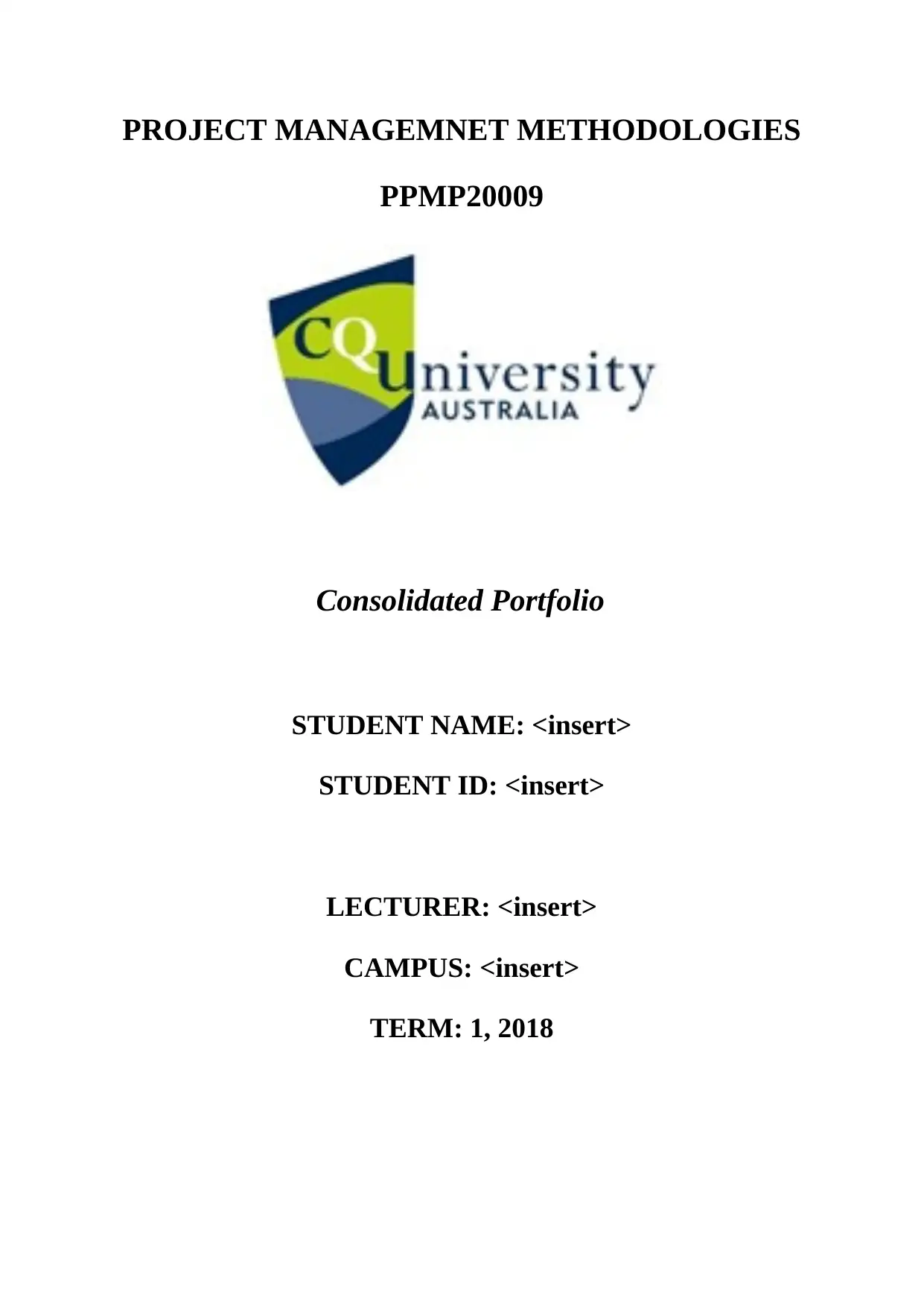
PROJECT MANAGEMNET METHODOLOGIES
PPMP20009
Consolidated Portfolio
STUDENT NAME: <insert>
STUDENT ID: <insert>
LECTURER: <insert>
CAMPUS: <insert>
TERM: 1, 2018
PPMP20009
Consolidated Portfolio
STUDENT NAME: <insert>
STUDENT ID: <insert>
LECTURER: <insert>
CAMPUS: <insert>
TERM: 1, 2018
Paraphrase This Document
Need a fresh take? Get an instant paraphrase of this document with our AI Paraphraser
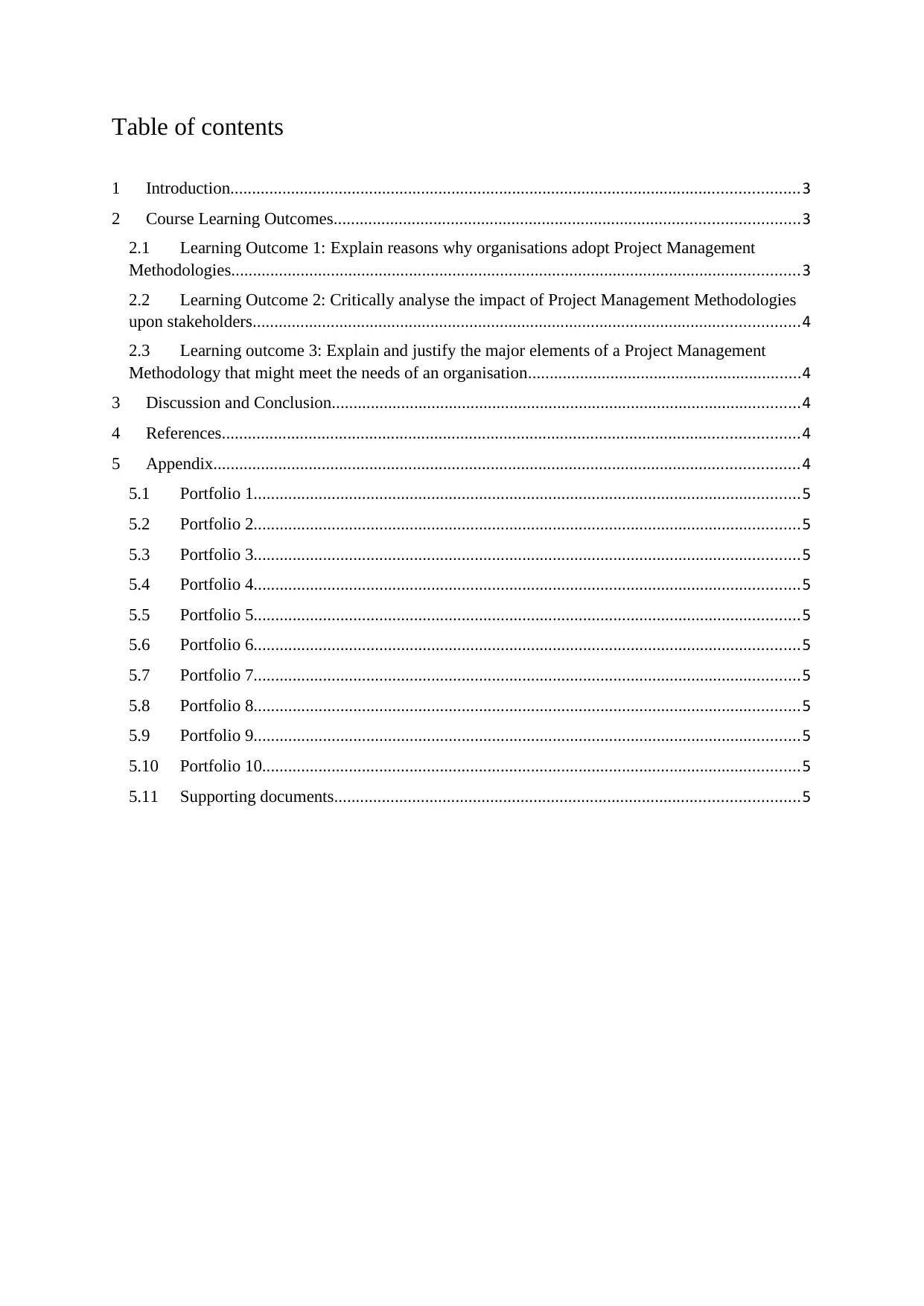
Table of contents
1 Introduction...................................................................................................................................3
2 Course Learning Outcomes...........................................................................................................3
2.1 Learning Outcome 1: Explain reasons why organisations adopt Project Management
Methodologies...................................................................................................................................3
2.2 Learning Outcome 2: Critically analyse the impact of Project Management Methodologies
upon stakeholders..............................................................................................................................4
2.3 Learning outcome 3: Explain and justify the major elements of a Project Management
Methodology that might meet the needs of an organisation...............................................................4
3 Discussion and Conclusion............................................................................................................4
4 References.....................................................................................................................................4
5 Appendix.......................................................................................................................................4
5.1 Portfolio 1..............................................................................................................................5
5.2 Portfolio 2..............................................................................................................................5
5.3 Portfolio 3..............................................................................................................................5
5.4 Portfolio 4..............................................................................................................................5
5.5 Portfolio 5..............................................................................................................................5
5.6 Portfolio 6..............................................................................................................................5
5.7 Portfolio 7..............................................................................................................................5
5.8 Portfolio 8..............................................................................................................................5
5.9 Portfolio 9..............................................................................................................................5
5.10 Portfolio 10............................................................................................................................5
5.11 Supporting documents...........................................................................................................5
1 Introduction...................................................................................................................................3
2 Course Learning Outcomes...........................................................................................................3
2.1 Learning Outcome 1: Explain reasons why organisations adopt Project Management
Methodologies...................................................................................................................................3
2.2 Learning Outcome 2: Critically analyse the impact of Project Management Methodologies
upon stakeholders..............................................................................................................................4
2.3 Learning outcome 3: Explain and justify the major elements of a Project Management
Methodology that might meet the needs of an organisation...............................................................4
3 Discussion and Conclusion............................................................................................................4
4 References.....................................................................................................................................4
5 Appendix.......................................................................................................................................4
5.1 Portfolio 1..............................................................................................................................5
5.2 Portfolio 2..............................................................................................................................5
5.3 Portfolio 3..............................................................................................................................5
5.4 Portfolio 4..............................................................................................................................5
5.5 Portfolio 5..............................................................................................................................5
5.6 Portfolio 6..............................................................................................................................5
5.7 Portfolio 7..............................................................................................................................5
5.8 Portfolio 8..............................................................................................................................5
5.9 Portfolio 9..............................................................................................................................5
5.10 Portfolio 10............................................................................................................................5
5.11 Supporting documents...........................................................................................................5
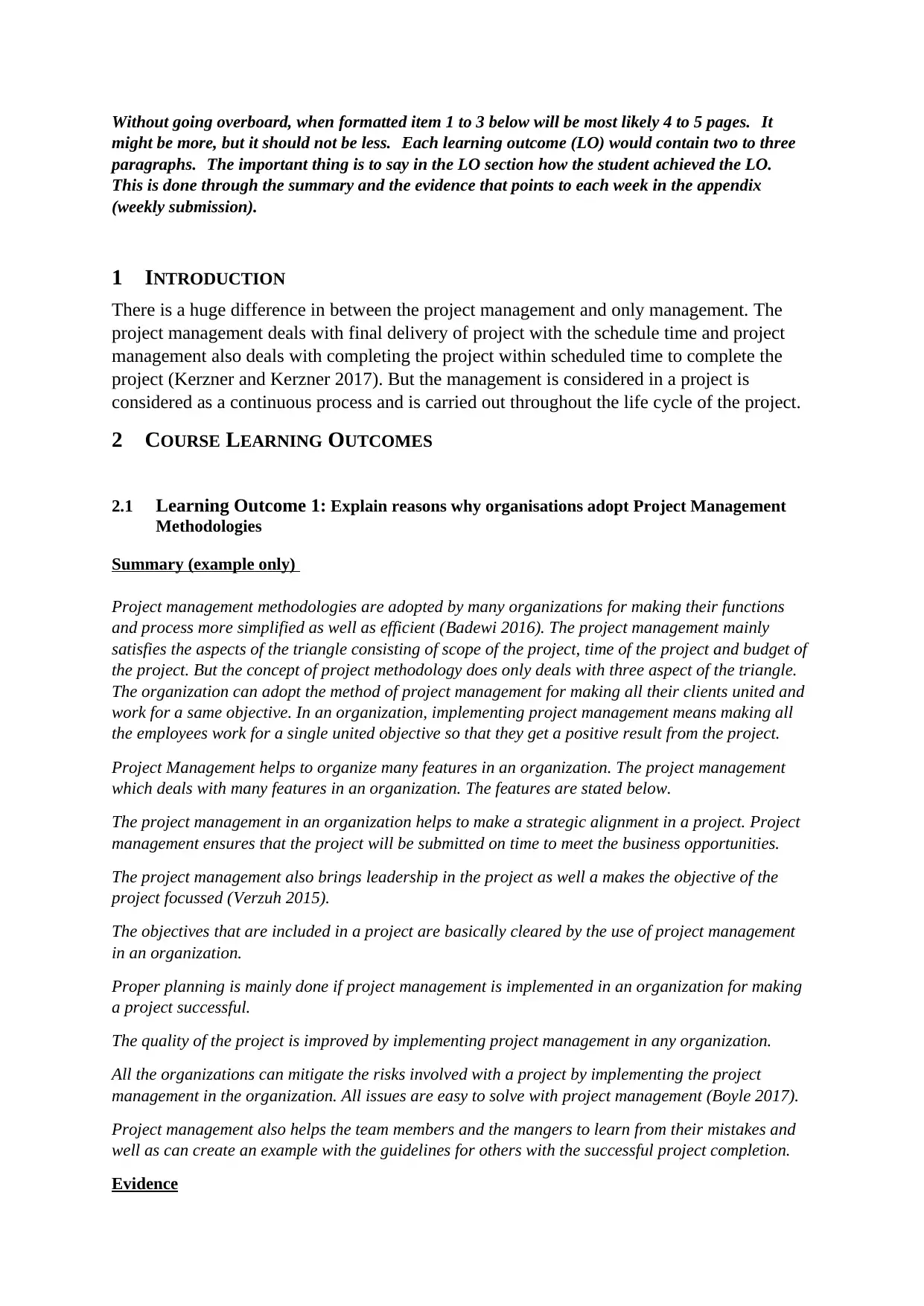
Without going overboard, when formatted item 1 to 3 below will be most likely 4 to 5 pages. It
might be more, but it should not be less. Each learning outcome (LO) would contain two to three
paragraphs. The important thing is to say in the LO section how the student achieved the LO.
This is done through the summary and the evidence that points to each week in the appendix
(weekly submission).
1 INTRODUCTION
There is a huge difference in between the project management and only management. The
project management deals with final delivery of project with the schedule time and project
management also deals with completing the project within scheduled time to complete the
project (Kerzner and Kerzner 2017). But the management is considered in a project is
considered as a continuous process and is carried out throughout the life cycle of the project.
2 COURSE LEARNING OUTCOMES
2.1 Learning Outcome 1: Explain reasons why organisations adopt Project Management
Methodologies
Summary (example only)
Project management methodologies are adopted by many organizations for making their functions
and process more simplified as well as efficient (Badewi 2016). The project management mainly
satisfies the aspects of the triangle consisting of scope of the project, time of the project and budget of
the project. But the concept of project methodology does only deals with three aspect of the triangle.
The organization can adopt the method of project management for making all their clients united and
work for a same objective. In an organization, implementing project management means making all
the employees work for a single united objective so that they get a positive result from the project.
Project Management helps to organize many features in an organization. The project management
which deals with many features in an organization. The features are stated below.
The project management in an organization helps to make a strategic alignment in a project. Project
management ensures that the project will be submitted on time to meet the business opportunities.
The project management also brings leadership in the project as well a makes the objective of the
project focussed (Verzuh 2015).
The objectives that are included in a project are basically cleared by the use of project management
in an organization.
Proper planning is mainly done if project management is implemented in an organization for making
a project successful.
The quality of the project is improved by implementing project management in any organization.
All the organizations can mitigate the risks involved with a project by implementing the project
management in the organization. All issues are easy to solve with project management (Boyle 2017).
Project management also helps the team members and the mangers to learn from their mistakes and
well as can create an example with the guidelines for others with the successful project completion.
Evidence
might be more, but it should not be less. Each learning outcome (LO) would contain two to three
paragraphs. The important thing is to say in the LO section how the student achieved the LO.
This is done through the summary and the evidence that points to each week in the appendix
(weekly submission).
1 INTRODUCTION
There is a huge difference in between the project management and only management. The
project management deals with final delivery of project with the schedule time and project
management also deals with completing the project within scheduled time to complete the
project (Kerzner and Kerzner 2017). But the management is considered in a project is
considered as a continuous process and is carried out throughout the life cycle of the project.
2 COURSE LEARNING OUTCOMES
2.1 Learning Outcome 1: Explain reasons why organisations adopt Project Management
Methodologies
Summary (example only)
Project management methodologies are adopted by many organizations for making their functions
and process more simplified as well as efficient (Badewi 2016). The project management mainly
satisfies the aspects of the triangle consisting of scope of the project, time of the project and budget of
the project. But the concept of project methodology does only deals with three aspect of the triangle.
The organization can adopt the method of project management for making all their clients united and
work for a same objective. In an organization, implementing project management means making all
the employees work for a single united objective so that they get a positive result from the project.
Project Management helps to organize many features in an organization. The project management
which deals with many features in an organization. The features are stated below.
The project management in an organization helps to make a strategic alignment in a project. Project
management ensures that the project will be submitted on time to meet the business opportunities.
The project management also brings leadership in the project as well a makes the objective of the
project focussed (Verzuh 2015).
The objectives that are included in a project are basically cleared by the use of project management
in an organization.
Proper planning is mainly done if project management is implemented in an organization for making
a project successful.
The quality of the project is improved by implementing project management in any organization.
All the organizations can mitigate the risks involved with a project by implementing the project
management in the organization. All issues are easy to solve with project management (Boyle 2017).
Project management also helps the team members and the mangers to learn from their mistakes and
well as can create an example with the guidelines for others with the successful project completion.
Evidence
⊘ This is a preview!⊘
Do you want full access?
Subscribe today to unlock all pages.

Trusted by 1+ million students worldwide
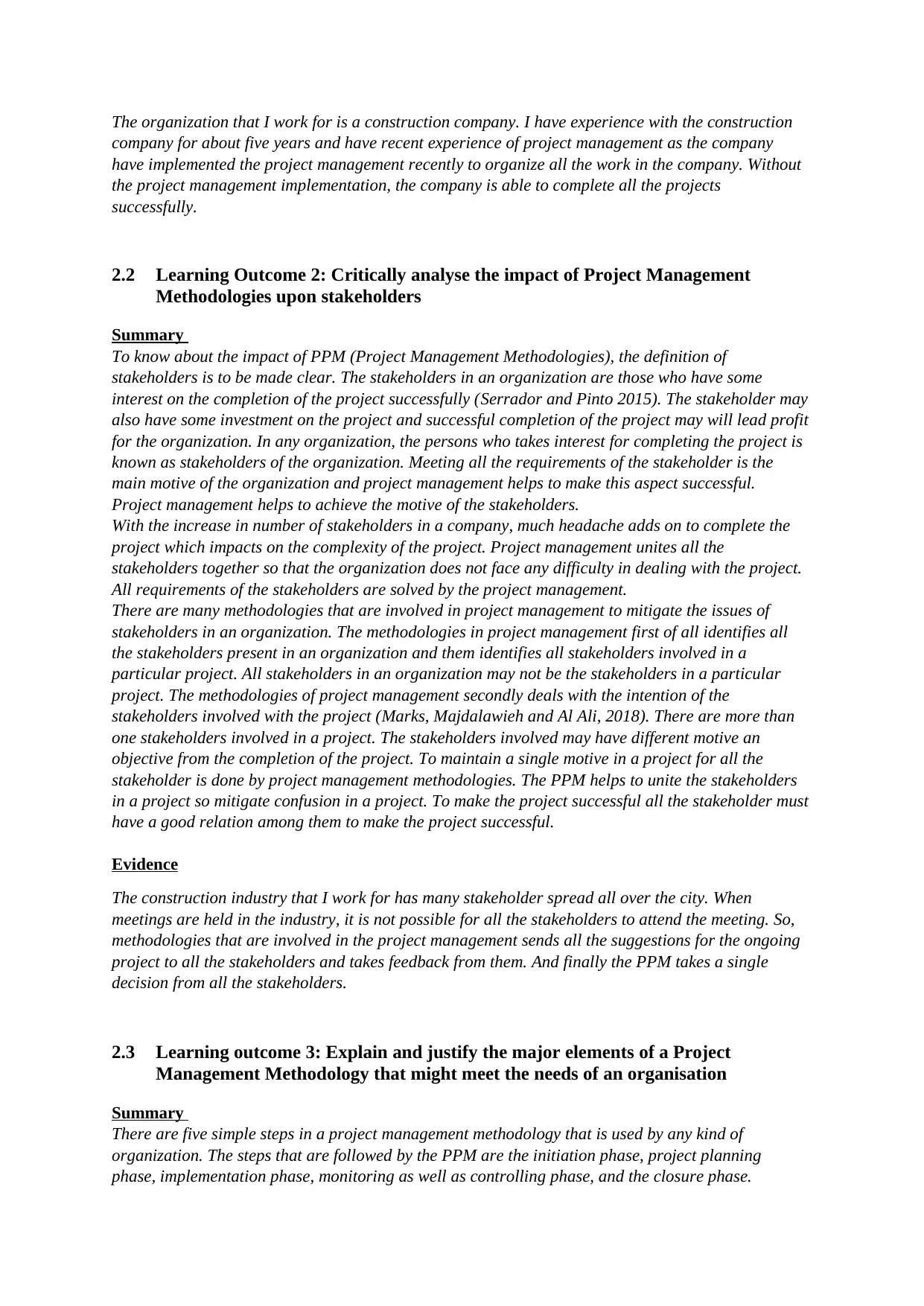
The organization that I work for is a construction company. I have experience with the construction
company for about five years and have recent experience of project management as the company
have implemented the project management recently to organize all the work in the company. Without
the project management implementation, the company is able to complete all the projects
successfully.
2.2 Learning Outcome 2: Critically analyse the impact of Project Management
Methodologies upon stakeholders
Summary
To know about the impact of PPM (Project Management Methodologies), the definition of
stakeholders is to be made clear. The stakeholders in an organization are those who have some
interest on the completion of the project successfully (Serrador and Pinto 2015). The stakeholder may
also have some investment on the project and successful completion of the project may will lead profit
for the organization. In any organization, the persons who takes interest for completing the project is
known as stakeholders of the organization. Meeting all the requirements of the stakeholder is the
main motive of the organization and project management helps to make this aspect successful.
Project management helps to achieve the motive of the stakeholders.
With the increase in number of stakeholders in a company, much headache adds on to complete the
project which impacts on the complexity of the project. Project management unites all the
stakeholders together so that the organization does not face any difficulty in dealing with the project.
All requirements of the stakeholders are solved by the project management.
There are many methodologies that are involved in project management to mitigate the issues of
stakeholders in an organization. The methodologies in project management first of all identifies all
the stakeholders present in an organization and them identifies all stakeholders involved in a
particular project. All stakeholders in an organization may not be the stakeholders in a particular
project. The methodologies of project management secondly deals with the intention of the
stakeholders involved with the project (Marks, Majdalawieh and Al Ali, 2018). There are more than
one stakeholders involved in a project. The stakeholders involved may have different motive an
objective from the completion of the project. To maintain a single motive in a project for all the
stakeholder is done by project management methodologies. The PPM helps to unite the stakeholders
in a project so mitigate confusion in a project. To make the project successful all the stakeholder must
have a good relation among them to make the project successful.
Evidence
The construction industry that I work for has many stakeholder spread all over the city. When
meetings are held in the industry, it is not possible for all the stakeholders to attend the meeting. So,
methodologies that are involved in the project management sends all the suggestions for the ongoing
project to all the stakeholders and takes feedback from them. And finally the PPM takes a single
decision from all the stakeholders.
2.3 Learning outcome 3: Explain and justify the major elements of a Project
Management Methodology that might meet the needs of an organisation
Summary
There are five simple steps in a project management methodology that is used by any kind of
organization. The steps that are followed by the PPM are the initiation phase, project planning
phase, implementation phase, monitoring as well as controlling phase, and the closure phase.
company for about five years and have recent experience of project management as the company
have implemented the project management recently to organize all the work in the company. Without
the project management implementation, the company is able to complete all the projects
successfully.
2.2 Learning Outcome 2: Critically analyse the impact of Project Management
Methodologies upon stakeholders
Summary
To know about the impact of PPM (Project Management Methodologies), the definition of
stakeholders is to be made clear. The stakeholders in an organization are those who have some
interest on the completion of the project successfully (Serrador and Pinto 2015). The stakeholder may
also have some investment on the project and successful completion of the project may will lead profit
for the organization. In any organization, the persons who takes interest for completing the project is
known as stakeholders of the organization. Meeting all the requirements of the stakeholder is the
main motive of the organization and project management helps to make this aspect successful.
Project management helps to achieve the motive of the stakeholders.
With the increase in number of stakeholders in a company, much headache adds on to complete the
project which impacts on the complexity of the project. Project management unites all the
stakeholders together so that the organization does not face any difficulty in dealing with the project.
All requirements of the stakeholders are solved by the project management.
There are many methodologies that are involved in project management to mitigate the issues of
stakeholders in an organization. The methodologies in project management first of all identifies all
the stakeholders present in an organization and them identifies all stakeholders involved in a
particular project. All stakeholders in an organization may not be the stakeholders in a particular
project. The methodologies of project management secondly deals with the intention of the
stakeholders involved with the project (Marks, Majdalawieh and Al Ali, 2018). There are more than
one stakeholders involved in a project. The stakeholders involved may have different motive an
objective from the completion of the project. To maintain a single motive in a project for all the
stakeholder is done by project management methodologies. The PPM helps to unite the stakeholders
in a project so mitigate confusion in a project. To make the project successful all the stakeholder must
have a good relation among them to make the project successful.
Evidence
The construction industry that I work for has many stakeholder spread all over the city. When
meetings are held in the industry, it is not possible for all the stakeholders to attend the meeting. So,
methodologies that are involved in the project management sends all the suggestions for the ongoing
project to all the stakeholders and takes feedback from them. And finally the PPM takes a single
decision from all the stakeholders.
2.3 Learning outcome 3: Explain and justify the major elements of a Project
Management Methodology that might meet the needs of an organisation
Summary
There are five simple steps in a project management methodology that is used by any kind of
organization. The steps that are followed by the PPM are the initiation phase, project planning
phase, implementation phase, monitoring as well as controlling phase, and the closure phase.
Paraphrase This Document
Need a fresh take? Get an instant paraphrase of this document with our AI Paraphraser
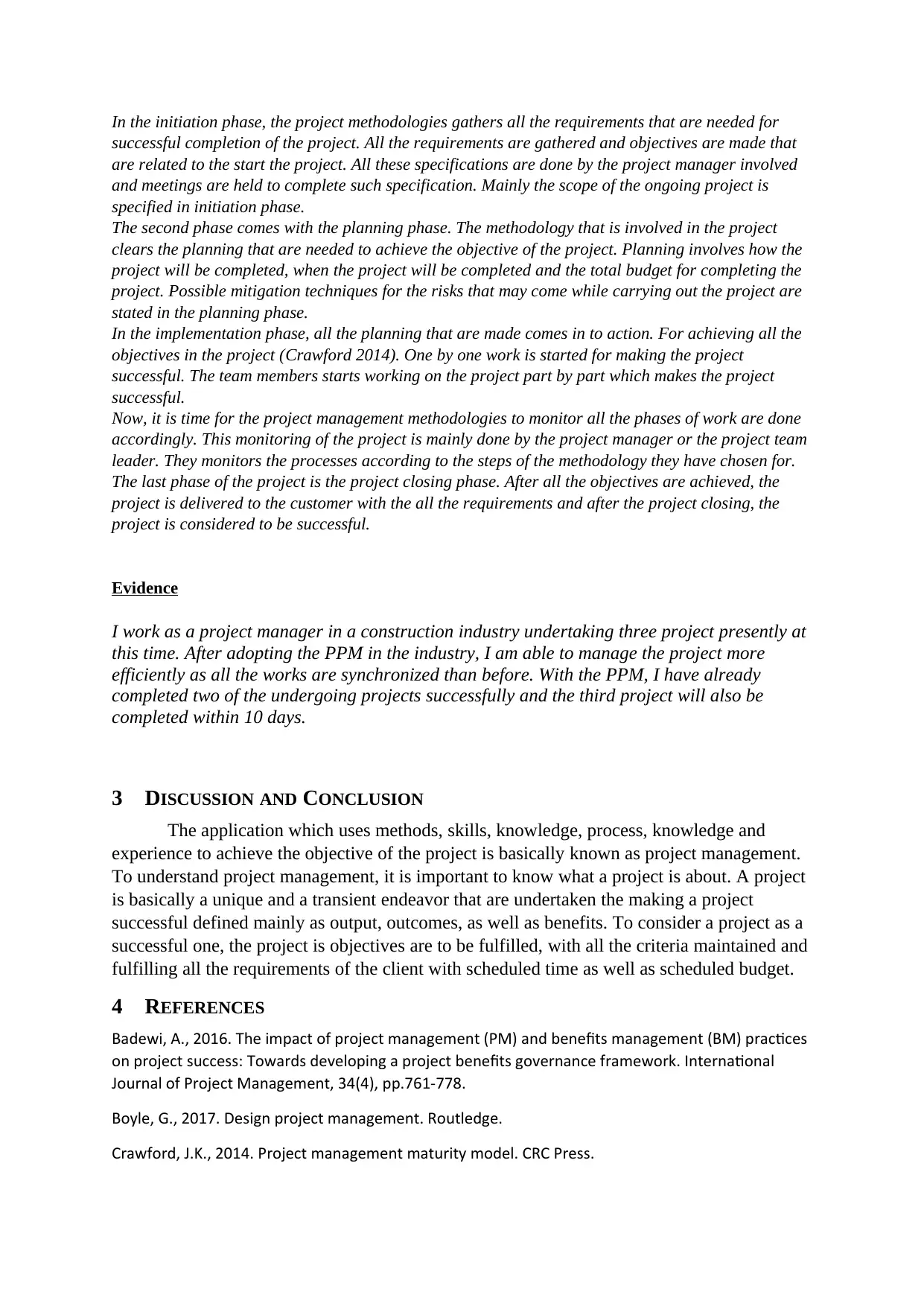
In the initiation phase, the project methodologies gathers all the requirements that are needed for
successful completion of the project. All the requirements are gathered and objectives are made that
are related to the start the project. All these specifications are done by the project manager involved
and meetings are held to complete such specification. Mainly the scope of the ongoing project is
specified in initiation phase.
The second phase comes with the planning phase. The methodology that is involved in the project
clears the planning that are needed to achieve the objective of the project. Planning involves how the
project will be completed, when the project will be completed and the total budget for completing the
project. Possible mitigation techniques for the risks that may come while carrying out the project are
stated in the planning phase.
In the implementation phase, all the planning that are made comes in to action. For achieving all the
objectives in the project (Crawford 2014). One by one work is started for making the project
successful. The team members starts working on the project part by part which makes the project
successful.
Now, it is time for the project management methodologies to monitor all the phases of work are done
accordingly. This monitoring of the project is mainly done by the project manager or the project team
leader. They monitors the processes according to the steps of the methodology they have chosen for.
The last phase of the project is the project closing phase. After all the objectives are achieved, the
project is delivered to the customer with the all the requirements and after the project closing, the
project is considered to be successful.
Evidence
I work as a project manager in a construction industry undertaking three project presently at
this time. After adopting the PPM in the industry, I am able to manage the project more
efficiently as all the works are synchronized than before. With the PPM, I have already
completed two of the undergoing projects successfully and the third project will also be
completed within 10 days.
3 DISCUSSION AND CONCLUSION
The application which uses methods, skills, knowledge, process, knowledge and
experience to achieve the objective of the project is basically known as project management.
To understand project management, it is important to know what a project is about. A project
is basically a unique and a transient endeavor that are undertaken the making a project
successful defined mainly as output, outcomes, as well as benefits. To consider a project as a
successful one, the project is objectives are to be fulfilled, with all the criteria maintained and
fulfilling all the requirements of the client with scheduled time as well as scheduled budget.
4 REFERENCES
Badewi, A., 2016. The impact of project management (PM) and benefits management (BM) practices
on project success: Towards developing a project benefits governance framework. International
Journal of Project Management, 34(4), pp.761-778.
Boyle, G., 2017. Design project management. Routledge.
Crawford, J.K., 2014. Project management maturity model. CRC Press.
successful completion of the project. All the requirements are gathered and objectives are made that
are related to the start the project. All these specifications are done by the project manager involved
and meetings are held to complete such specification. Mainly the scope of the ongoing project is
specified in initiation phase.
The second phase comes with the planning phase. The methodology that is involved in the project
clears the planning that are needed to achieve the objective of the project. Planning involves how the
project will be completed, when the project will be completed and the total budget for completing the
project. Possible mitigation techniques for the risks that may come while carrying out the project are
stated in the planning phase.
In the implementation phase, all the planning that are made comes in to action. For achieving all the
objectives in the project (Crawford 2014). One by one work is started for making the project
successful. The team members starts working on the project part by part which makes the project
successful.
Now, it is time for the project management methodologies to monitor all the phases of work are done
accordingly. This monitoring of the project is mainly done by the project manager or the project team
leader. They monitors the processes according to the steps of the methodology they have chosen for.
The last phase of the project is the project closing phase. After all the objectives are achieved, the
project is delivered to the customer with the all the requirements and after the project closing, the
project is considered to be successful.
Evidence
I work as a project manager in a construction industry undertaking three project presently at
this time. After adopting the PPM in the industry, I am able to manage the project more
efficiently as all the works are synchronized than before. With the PPM, I have already
completed two of the undergoing projects successfully and the third project will also be
completed within 10 days.
3 DISCUSSION AND CONCLUSION
The application which uses methods, skills, knowledge, process, knowledge and
experience to achieve the objective of the project is basically known as project management.
To understand project management, it is important to know what a project is about. A project
is basically a unique and a transient endeavor that are undertaken the making a project
successful defined mainly as output, outcomes, as well as benefits. To consider a project as a
successful one, the project is objectives are to be fulfilled, with all the criteria maintained and
fulfilling all the requirements of the client with scheduled time as well as scheduled budget.
4 REFERENCES
Badewi, A., 2016. The impact of project management (PM) and benefits management (BM) practices
on project success: Towards developing a project benefits governance framework. International
Journal of Project Management, 34(4), pp.761-778.
Boyle, G., 2017. Design project management. Routledge.
Crawford, J.K., 2014. Project management maturity model. CRC Press.
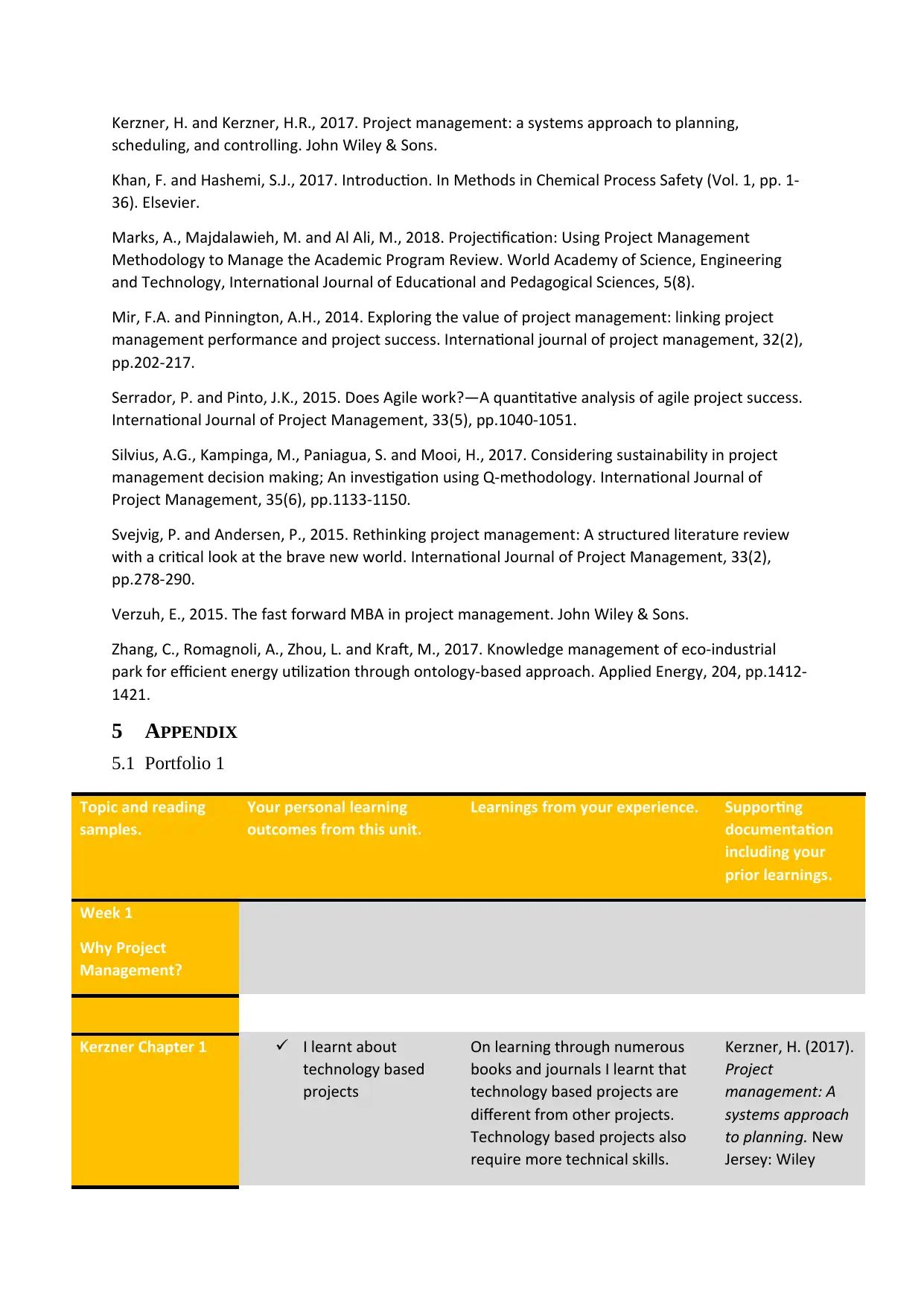
Kerzner, H. and Kerzner, H.R., 2017. Project management: a systems approach to planning,
scheduling, and controlling. John Wiley & Sons.
Khan, F. and Hashemi, S.J., 2017. Introduction. In Methods in Chemical Process Safety (Vol. 1, pp. 1-
36). Elsevier.
Marks, A., Majdalawieh, M. and Al Ali, M., 2018. Projectification: Using Project Management
Methodology to Manage the Academic Program Review. World Academy of Science, Engineering
and Technology, International Journal of Educational and Pedagogical Sciences, 5(8).
Mir, F.A. and Pinnington, A.H., 2014. Exploring the value of project management: linking project
management performance and project success. International journal of project management, 32(2),
pp.202-217.
Serrador, P. and Pinto, J.K., 2015. Does Agile work?—A quantitative analysis of agile project success.
International Journal of Project Management, 33(5), pp.1040-1051.
Silvius, A.G., Kampinga, M., Paniagua, S. and Mooi, H., 2017. Considering sustainability in project
management decision making; An investigation using Q-methodology. International Journal of
Project Management, 35(6), pp.1133-1150.
Svejvig, P. and Andersen, P., 2015. Rethinking project management: A structured literature review
with a critical look at the brave new world. International Journal of Project Management, 33(2),
pp.278-290.
Verzuh, E., 2015. The fast forward MBA in project management. John Wiley & Sons.
Zhang, C., Romagnoli, A., Zhou, L. and Kraft, M., 2017. Knowledge management of eco-industrial
park for efficient energy utilization through ontology-based approach. Applied Energy, 204, pp.1412-
1421.
5 APPENDIX
5.1 Portfolio 1
Topic and reading
samples.
Your personal learning
outcomes from this unit.
Learnings from your experience. Supporting
documentation
including your
prior learnings.
Week 1
Why Project
Management?
Kerzner Chapter 1 I learnt about
technology based
projects
On learning through numerous
books and journals I learnt that
technology based projects are
different from other projects.
Technology based projects also
require more technical skills.
Kerzner, H. (2017).
Project
management: A
systems approach
to planning. New
Jersey: Wiley
scheduling, and controlling. John Wiley & Sons.
Khan, F. and Hashemi, S.J., 2017. Introduction. In Methods in Chemical Process Safety (Vol. 1, pp. 1-
36). Elsevier.
Marks, A., Majdalawieh, M. and Al Ali, M., 2018. Projectification: Using Project Management
Methodology to Manage the Academic Program Review. World Academy of Science, Engineering
and Technology, International Journal of Educational and Pedagogical Sciences, 5(8).
Mir, F.A. and Pinnington, A.H., 2014. Exploring the value of project management: linking project
management performance and project success. International journal of project management, 32(2),
pp.202-217.
Serrador, P. and Pinto, J.K., 2015. Does Agile work?—A quantitative analysis of agile project success.
International Journal of Project Management, 33(5), pp.1040-1051.
Silvius, A.G., Kampinga, M., Paniagua, S. and Mooi, H., 2017. Considering sustainability in project
management decision making; An investigation using Q-methodology. International Journal of
Project Management, 35(6), pp.1133-1150.
Svejvig, P. and Andersen, P., 2015. Rethinking project management: A structured literature review
with a critical look at the brave new world. International Journal of Project Management, 33(2),
pp.278-290.
Verzuh, E., 2015. The fast forward MBA in project management. John Wiley & Sons.
Zhang, C., Romagnoli, A., Zhou, L. and Kraft, M., 2017. Knowledge management of eco-industrial
park for efficient energy utilization through ontology-based approach. Applied Energy, 204, pp.1412-
1421.
5 APPENDIX
5.1 Portfolio 1
Topic and reading
samples.
Your personal learning
outcomes from this unit.
Learnings from your experience. Supporting
documentation
including your
prior learnings.
Week 1
Why Project
Management?
Kerzner Chapter 1 I learnt about
technology based
projects
On learning through numerous
books and journals I learnt that
technology based projects are
different from other projects.
Technology based projects also
require more technical skills.
Kerzner, H. (2017).
Project
management: A
systems approach
to planning. New
Jersey: Wiley
⊘ This is a preview!⊘
Do you want full access?
Subscribe today to unlock all pages.

Trusted by 1+ million students worldwide
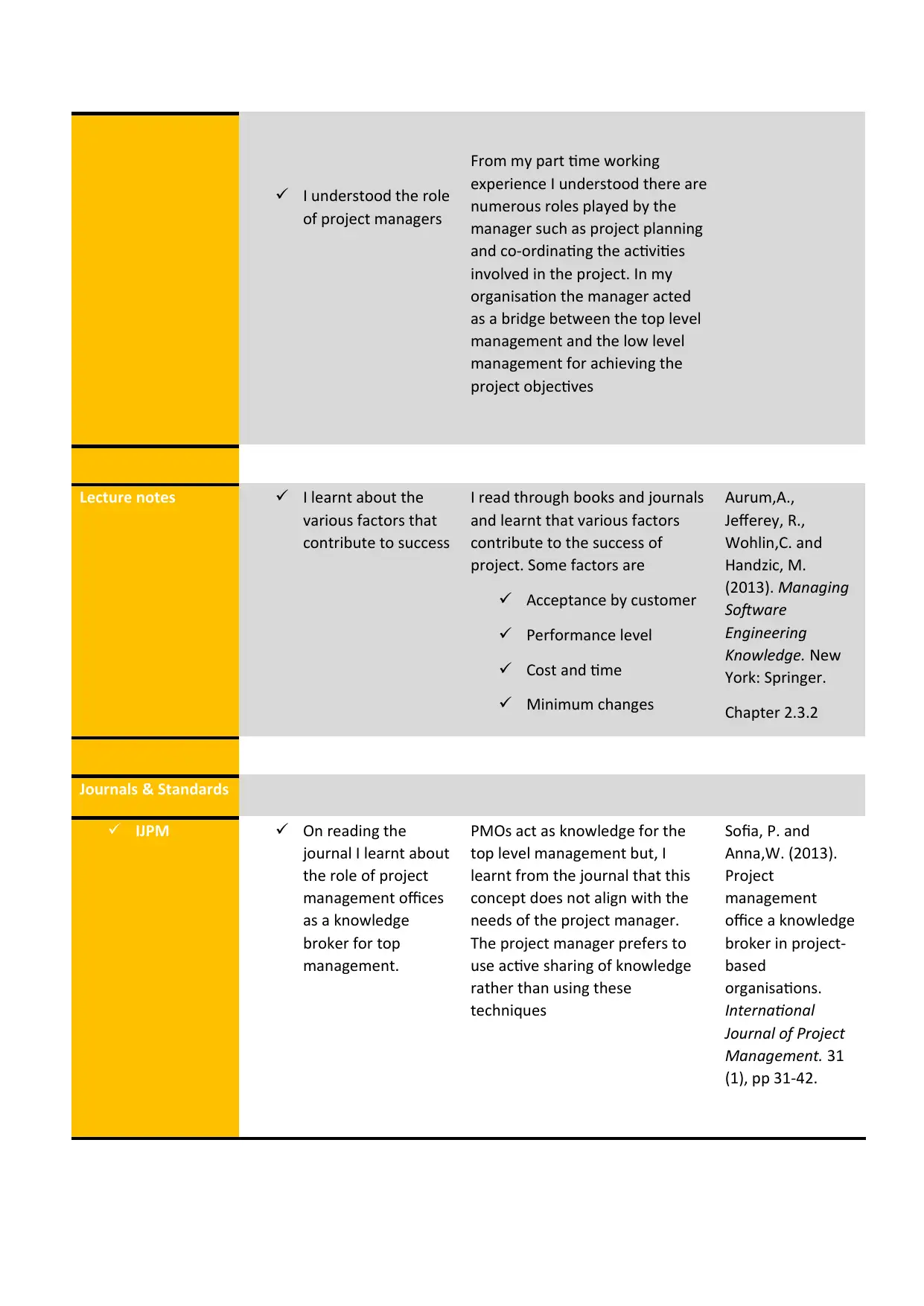
I understood the role
of project managers
From my part time working
experience I understood there are
numerous roles played by the
manager such as project planning
and co-ordinating the activities
involved in the project. In my
organisation the manager acted
as a bridge between the top level
management and the low level
management for achieving the
project objectives
Lecture notes I learnt about the
various factors that
contribute to success
I read through books and journals
and learnt that various factors
contribute to the success of
project. Some factors are
Acceptance by customer
Performance level
Cost and time
Minimum changes
Aurum,A.,
Jefferey, R.,
Wohlin,C. and
Handzic, M.
(2013). Managing
Software
Engineering
Knowledge. New
York: Springer.
Chapter 2.3.2
Journals & Standards
IJPM On reading the
journal I learnt about
the role of project
management offices
as a knowledge
broker for top
management.
PMOs act as knowledge for the
top level management but, I
learnt from the journal that this
concept does not align with the
needs of the project manager.
The project manager prefers to
use active sharing of knowledge
rather than using these
techniques
Sofia, P. and
Anna,W. (2013).
Project
management
office a knowledge
broker in project-
based
organisations.
International
Journal of Project
Management. 31
(1), pp 31-42.
of project managers
From my part time working
experience I understood there are
numerous roles played by the
manager such as project planning
and co-ordinating the activities
involved in the project. In my
organisation the manager acted
as a bridge between the top level
management and the low level
management for achieving the
project objectives
Lecture notes I learnt about the
various factors that
contribute to success
I read through books and journals
and learnt that various factors
contribute to the success of
project. Some factors are
Acceptance by customer
Performance level
Cost and time
Minimum changes
Aurum,A.,
Jefferey, R.,
Wohlin,C. and
Handzic, M.
(2013). Managing
Software
Engineering
Knowledge. New
York: Springer.
Chapter 2.3.2
Journals & Standards
IJPM On reading the
journal I learnt about
the role of project
management offices
as a knowledge
broker for top
management.
PMOs act as knowledge for the
top level management but, I
learnt from the journal that this
concept does not align with the
needs of the project manager.
The project manager prefers to
use active sharing of knowledge
rather than using these
techniques
Sofia, P. and
Anna,W. (2013).
Project
management
office a knowledge
broker in project-
based
organisations.
International
Journal of Project
Management. 31
(1), pp 31-42.
Paraphrase This Document
Need a fresh take? Get an instant paraphrase of this document with our AI Paraphraser
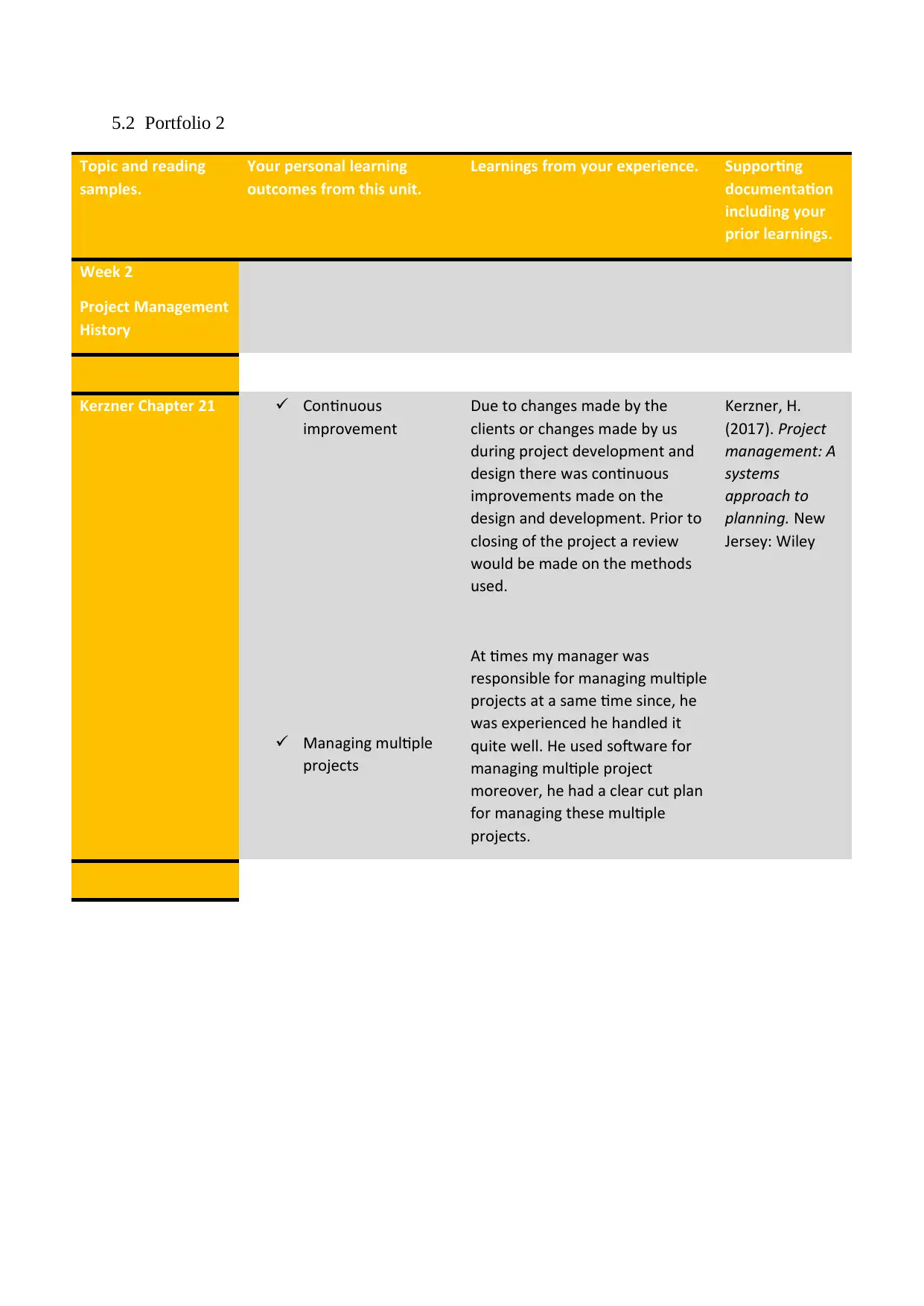
5.2 Portfolio 2
Topic and reading
samples.
Your personal learning
outcomes from this unit.
Learnings from your experience. Supporting
documentation
including your
prior learnings.
Week 2
Project Management
History
Kerzner Chapter 21 Continuous
improvement
Managing multiple
projects
Due to changes made by the
clients or changes made by us
during project development and
design there was continuous
improvements made on the
design and development. Prior to
closing of the project a review
would be made on the methods
used.
At times my manager was
responsible for managing multiple
projects at a same time since, he
was experienced he handled it
quite well. He used software for
managing multiple project
moreover, he had a clear cut plan
for managing these multiple
projects.
Kerzner, H.
(2017). Project
management: A
systems
approach to
planning. New
Jersey: Wiley
Topic and reading
samples.
Your personal learning
outcomes from this unit.
Learnings from your experience. Supporting
documentation
including your
prior learnings.
Week 2
Project Management
History
Kerzner Chapter 21 Continuous
improvement
Managing multiple
projects
Due to changes made by the
clients or changes made by us
during project development and
design there was continuous
improvements made on the
design and development. Prior to
closing of the project a review
would be made on the methods
used.
At times my manager was
responsible for managing multiple
projects at a same time since, he
was experienced he handled it
quite well. He used software for
managing multiple project
moreover, he had a clear cut plan
for managing these multiple
projects.
Kerzner, H.
(2017). Project
management: A
systems
approach to
planning. New
Jersey: Wiley
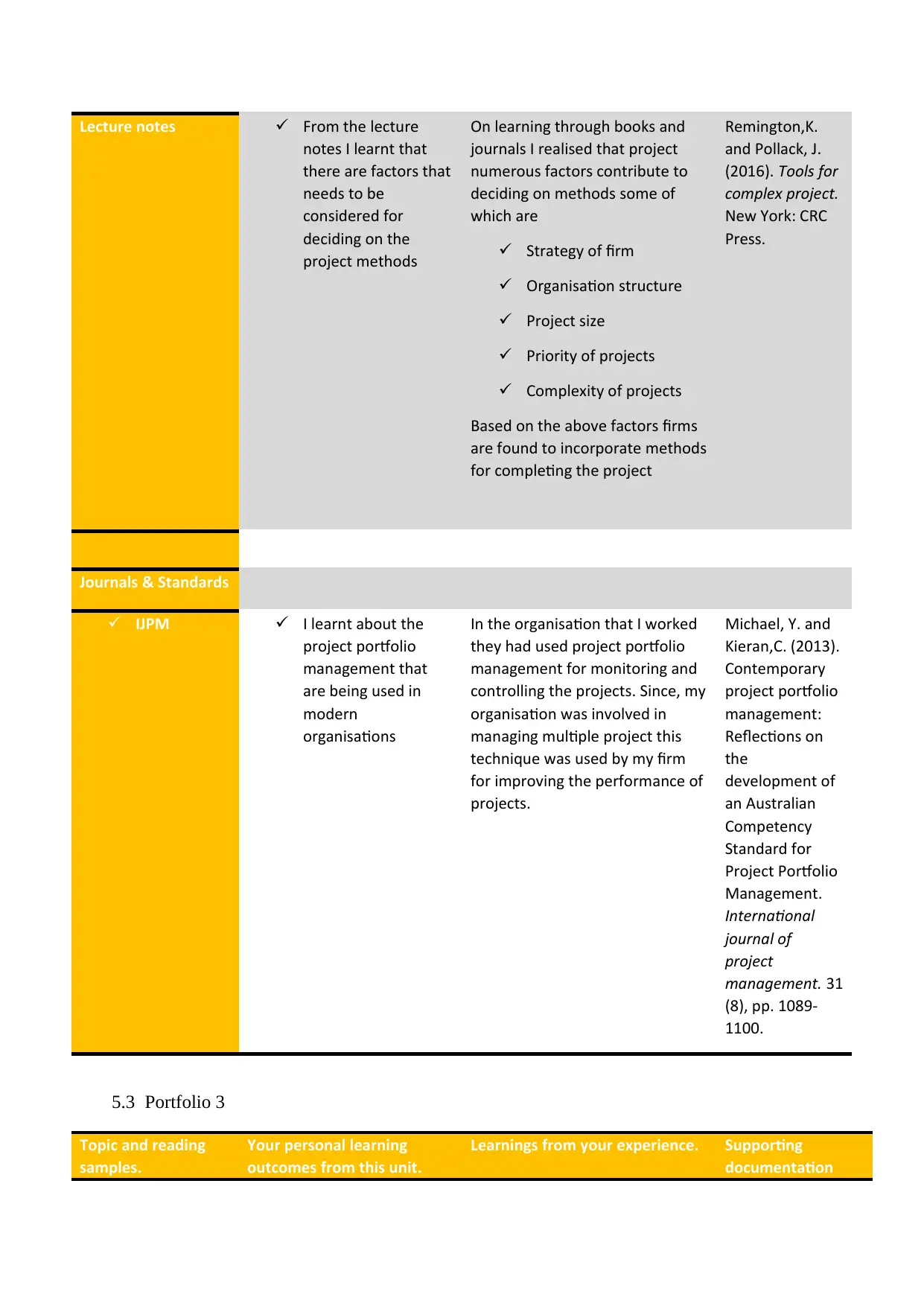
Lecture notes From the lecture
notes I learnt that
there are factors that
needs to be
considered for
deciding on the
project methods
On learning through books and
journals I realised that project
numerous factors contribute to
deciding on methods some of
which are
Strategy of firm
Organisation structure
Project size
Priority of projects
Complexity of projects
Based on the above factors firms
are found to incorporate methods
for completing the project
Remington,K.
and Pollack, J.
(2016). Tools for
complex project.
New York: CRC
Press.
Journals & Standards
IJPM I learnt about the
project portfolio
management that
are being used in
modern
organisations
In the organisation that I worked
they had used project portfolio
management for monitoring and
controlling the projects. Since, my
organisation was involved in
managing multiple project this
technique was used by my firm
for improving the performance of
projects.
Michael, Y. and
Kieran,C. (2013).
Contemporary
project portfolio
management:
Reflections on
the
development of
an Australian
Competency
Standard for
Project Portfolio
Management.
International
journal of
project
management. 31
(8), pp. 1089-
1100.
5.3 Portfolio 3
Topic and reading
samples.
Your personal learning
outcomes from this unit.
Learnings from your experience. Supporting
documentation
notes I learnt that
there are factors that
needs to be
considered for
deciding on the
project methods
On learning through books and
journals I realised that project
numerous factors contribute to
deciding on methods some of
which are
Strategy of firm
Organisation structure
Project size
Priority of projects
Complexity of projects
Based on the above factors firms
are found to incorporate methods
for completing the project
Remington,K.
and Pollack, J.
(2016). Tools for
complex project.
New York: CRC
Press.
Journals & Standards
IJPM I learnt about the
project portfolio
management that
are being used in
modern
organisations
In the organisation that I worked
they had used project portfolio
management for monitoring and
controlling the projects. Since, my
organisation was involved in
managing multiple project this
technique was used by my firm
for improving the performance of
projects.
Michael, Y. and
Kieran,C. (2013).
Contemporary
project portfolio
management:
Reflections on
the
development of
an Australian
Competency
Standard for
Project Portfolio
Management.
International
journal of
project
management. 31
(8), pp. 1089-
1100.
5.3 Portfolio 3
Topic and reading
samples.
Your personal learning
outcomes from this unit.
Learnings from your experience. Supporting
documentation
⊘ This is a preview!⊘
Do you want full access?
Subscribe today to unlock all pages.

Trusted by 1+ million students worldwide
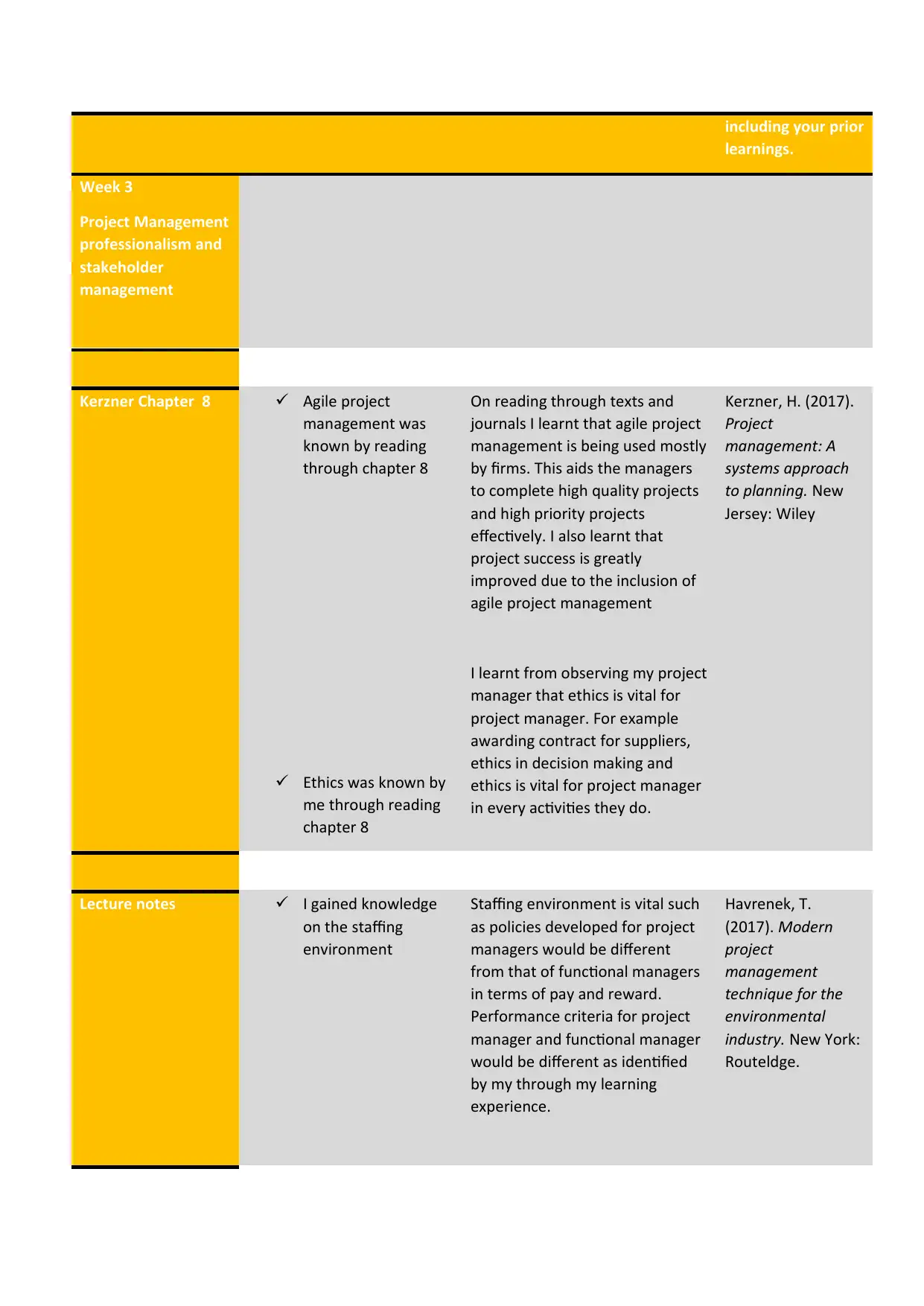
including your prior
learnings.
Week 3
Project Management
professionalism and
stakeholder
management
Kerzner Chapter 8 Agile project
management was
known by reading
through chapter 8
Ethics was known by
me through reading
chapter 8
On reading through texts and
journals I learnt that agile project
management is being used mostly
by firms. This aids the managers
to complete high quality projects
and high priority projects
effectively. I also learnt that
project success is greatly
improved due to the inclusion of
agile project management
I learnt from observing my project
manager that ethics is vital for
project manager. For example
awarding contract for suppliers,
ethics in decision making and
ethics is vital for project manager
in every activities they do.
Kerzner, H. (2017).
Project
management: A
systems approach
to planning. New
Jersey: Wiley
Lecture notes I gained knowledge
on the staffing
environment
Staffing environment is vital such
as policies developed for project
managers would be different
from that of functional managers
in terms of pay and reward.
Performance criteria for project
manager and functional manager
would be different as identified
by my through my learning
experience.
Havrenek, T.
(2017). Modern
project
management
technique for the
environmental
industry. New York:
Routeldge.
learnings.
Week 3
Project Management
professionalism and
stakeholder
management
Kerzner Chapter 8 Agile project
management was
known by reading
through chapter 8
Ethics was known by
me through reading
chapter 8
On reading through texts and
journals I learnt that agile project
management is being used mostly
by firms. This aids the managers
to complete high quality projects
and high priority projects
effectively. I also learnt that
project success is greatly
improved due to the inclusion of
agile project management
I learnt from observing my project
manager that ethics is vital for
project manager. For example
awarding contract for suppliers,
ethics in decision making and
ethics is vital for project manager
in every activities they do.
Kerzner, H. (2017).
Project
management: A
systems approach
to planning. New
Jersey: Wiley
Lecture notes I gained knowledge
on the staffing
environment
Staffing environment is vital such
as policies developed for project
managers would be different
from that of functional managers
in terms of pay and reward.
Performance criteria for project
manager and functional manager
would be different as identified
by my through my learning
experience.
Havrenek, T.
(2017). Modern
project
management
technique for the
environmental
industry. New York:
Routeldge.
Paraphrase This Document
Need a fresh take? Get an instant paraphrase of this document with our AI Paraphraser
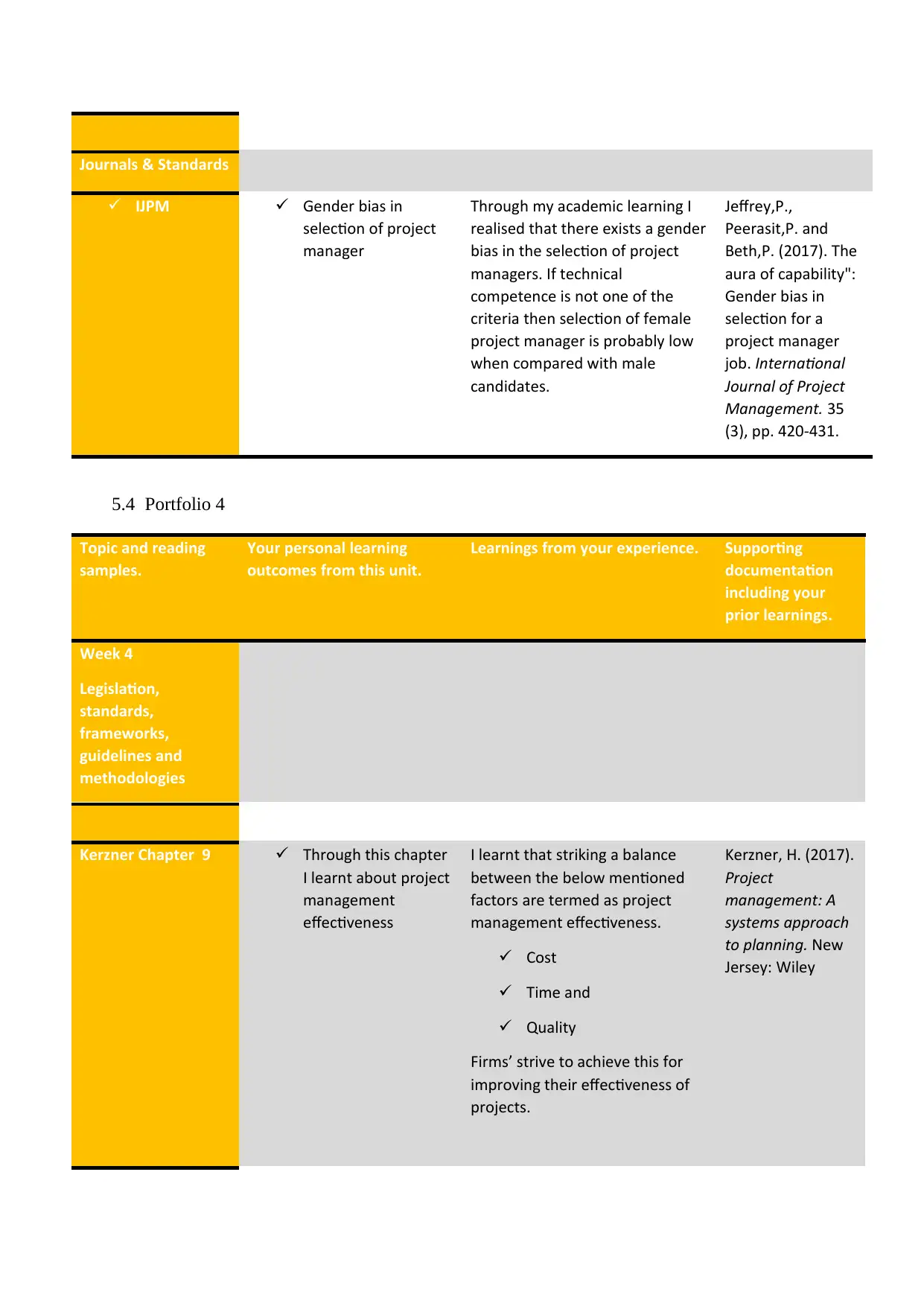
Journals & Standards
IJPM Gender bias in
selection of project
manager
Through my academic learning I
realised that there exists a gender
bias in the selection of project
managers. If technical
competence is not one of the
criteria then selection of female
project manager is probably low
when compared with male
candidates.
Jeffrey,P.,
Peerasit,P. and
Beth,P. (2017). The
aura of capability":
Gender bias in
selection for a
project manager
job. International
Journal of Project
Management. 35
(3), pp. 420-431.
5.4 Portfolio 4
Topic and reading
samples.
Your personal learning
outcomes from this unit.
Learnings from your experience. Supporting
documentation
including your
prior learnings.
Week 4
Legislation,
standards,
frameworks,
guidelines and
methodologies
Kerzner Chapter 9 Through this chapter
I learnt about project
management
effectiveness
I learnt that striking a balance
between the below mentioned
factors are termed as project
management effectiveness.
Cost
Time and
Quality
Firms’ strive to achieve this for
improving their effectiveness of
projects.
Kerzner, H. (2017).
Project
management: A
systems approach
to planning. New
Jersey: Wiley
IJPM Gender bias in
selection of project
manager
Through my academic learning I
realised that there exists a gender
bias in the selection of project
managers. If technical
competence is not one of the
criteria then selection of female
project manager is probably low
when compared with male
candidates.
Jeffrey,P.,
Peerasit,P. and
Beth,P. (2017). The
aura of capability":
Gender bias in
selection for a
project manager
job. International
Journal of Project
Management. 35
(3), pp. 420-431.
5.4 Portfolio 4
Topic and reading
samples.
Your personal learning
outcomes from this unit.
Learnings from your experience. Supporting
documentation
including your
prior learnings.
Week 4
Legislation,
standards,
frameworks,
guidelines and
methodologies
Kerzner Chapter 9 Through this chapter
I learnt about project
management
effectiveness
I learnt that striking a balance
between the below mentioned
factors are termed as project
management effectiveness.
Cost
Time and
Quality
Firms’ strive to achieve this for
improving their effectiveness of
projects.
Kerzner, H. (2017).
Project
management: A
systems approach
to planning. New
Jersey: Wiley
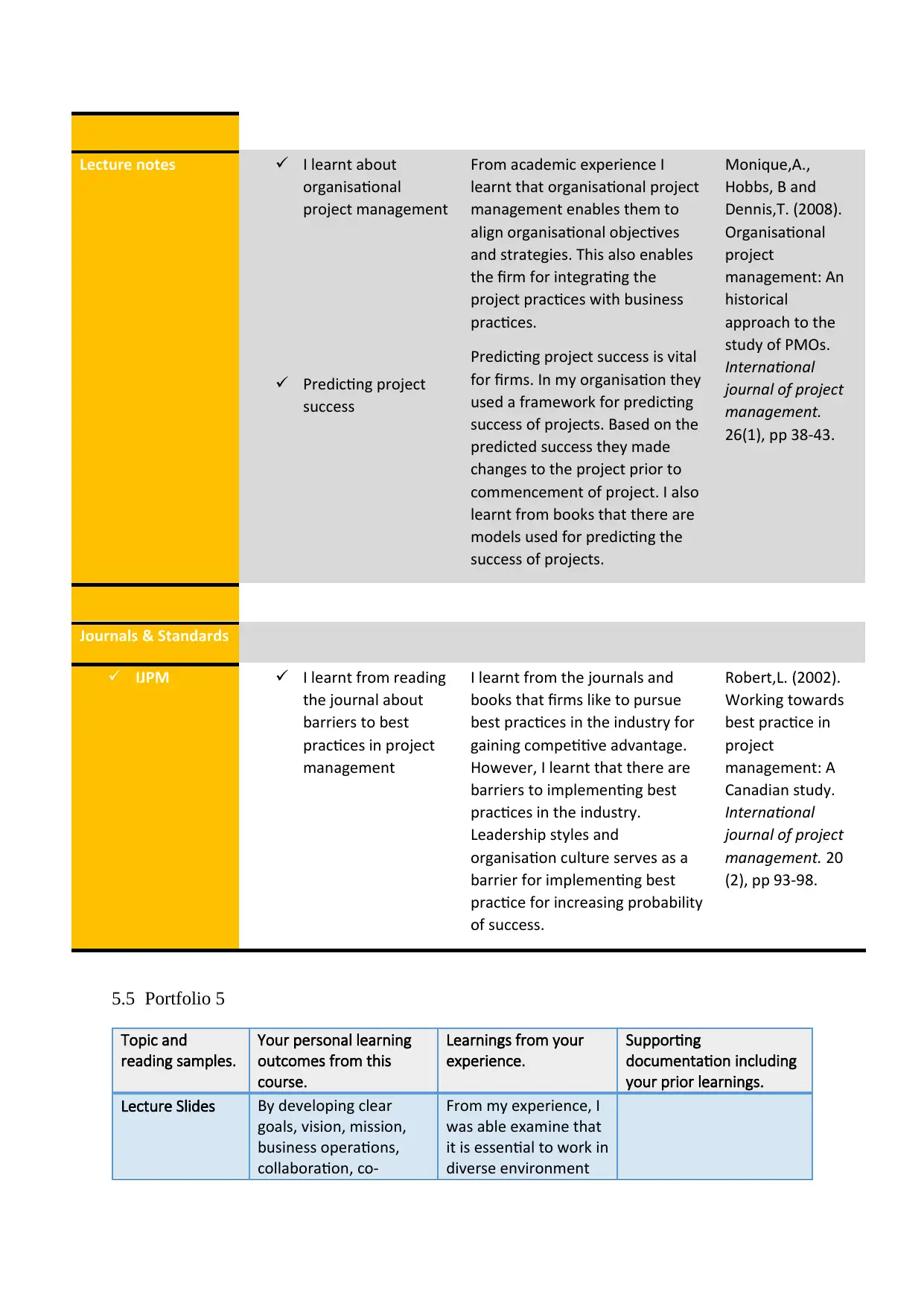
Lecture notes I learnt about
organisational
project management
Predicting project
success
From academic experience I
learnt that organisational project
management enables them to
align organisational objectives
and strategies. This also enables
the firm for integrating the
project practices with business
practices.
Predicting project success is vital
for firms. In my organisation they
used a framework for predicting
success of projects. Based on the
predicted success they made
changes to the project prior to
commencement of project. I also
learnt from books that there are
models used for predicting the
success of projects.
Monique,A.,
Hobbs, B and
Dennis,T. (2008).
Organisational
project
management: An
historical
approach to the
study of PMOs.
International
journal of project
management.
26(1), pp 38-43.
Journals & Standards
IJPM I learnt from reading
the journal about
barriers to best
practices in project
management
I learnt from the journals and
books that firms like to pursue
best practices in the industry for
gaining competitive advantage.
However, I learnt that there are
barriers to implementing best
practices in the industry.
Leadership styles and
organisation culture serves as a
barrier for implementing best
practice for increasing probability
of success.
Robert,L. (2002).
Working towards
best practice in
project
management: A
Canadian study.
International
journal of project
management. 20
(2), pp 93-98.
5.5 Portfolio 5
Topic and
reading samples.
Your personal learning
outcomes from this
course.
Learnings from your
experience.
Supporting
documentation including
your prior learnings.
Lecture Slides By developing clear
goals, vision, mission,
business operations,
collaboration, co-
From my experience, I
was able examine that
it is essential to work in
diverse environment
organisational
project management
Predicting project
success
From academic experience I
learnt that organisational project
management enables them to
align organisational objectives
and strategies. This also enables
the firm for integrating the
project practices with business
practices.
Predicting project success is vital
for firms. In my organisation they
used a framework for predicting
success of projects. Based on the
predicted success they made
changes to the project prior to
commencement of project. I also
learnt from books that there are
models used for predicting the
success of projects.
Monique,A.,
Hobbs, B and
Dennis,T. (2008).
Organisational
project
management: An
historical
approach to the
study of PMOs.
International
journal of project
management.
26(1), pp 38-43.
Journals & Standards
IJPM I learnt from reading
the journal about
barriers to best
practices in project
management
I learnt from the journals and
books that firms like to pursue
best practices in the industry for
gaining competitive advantage.
However, I learnt that there are
barriers to implementing best
practices in the industry.
Leadership styles and
organisation culture serves as a
barrier for implementing best
practice for increasing probability
of success.
Robert,L. (2002).
Working towards
best practice in
project
management: A
Canadian study.
International
journal of project
management. 20
(2), pp 93-98.
5.5 Portfolio 5
Topic and
reading samples.
Your personal learning
outcomes from this
course.
Learnings from your
experience.
Supporting
documentation including
your prior learnings.
Lecture Slides By developing clear
goals, vision, mission,
business operations,
collaboration, co-
From my experience, I
was able examine that
it is essential to work in
diverse environment
⊘ This is a preview!⊘
Do you want full access?
Subscribe today to unlock all pages.

Trusted by 1+ million students worldwide
1 out of 22
Related Documents
Your All-in-One AI-Powered Toolkit for Academic Success.
+13062052269
info@desklib.com
Available 24*7 on WhatsApp / Email
![[object Object]](/_next/static/media/star-bottom.7253800d.svg)
Unlock your academic potential
Copyright © 2020–2025 A2Z Services. All Rights Reserved. Developed and managed by ZUCOL.
